Welcome to our comprehensive guide on Azure Storage, the backbone of Microsoft’s robust cloud computing platform, Azure. In today’s fast-paced digital world, effective data storage and management are paramount for businesses of all sizes.
Azure Storage provides a scalable, secure, and highly available solution that empowers organizations to harness the full potential of cloud storage. Whether you’re a developer, IT professional, or business owner, understanding Azure Storage is essential for optimizing your cloud infrastructure and unleashing the true power of the cloud.
In this blog post, we will take an in-depth look at Azure Storage, exploring its key features, benefits, storage types, redundancy options, security measures, pricing, and more. Our goal is to provide you with the knowledge and insights to effectively leverage Azure Storage in your cloud solutions, regardless of your level of expertise.
So, let’s embark on this exciting journey and dive into the world of Azure Storage.
Table of Contents
Why Do We Need Storage?
Before we delve into the specifics of Azure Storage, let’s understand why storage is a critical aspect of cloud computing.
In today’s digital era, the importance of storage cannot be overstated. Storage plays a vital role in managing the vast amounts of data generated by individuals and organizations alike. Whether it’s customer information, product catalogs, financial records, or multimedia files, data is the lifeblood of modern businesses.
But why do we need storage? Let’s explore some key reasons:
1. Data Retention: Storage allows us to retain and preserve valuable data over time. Instead of relying on physical filing cabinets or scattered documents, digital storage provides a centralized and organized repository for data, making it easily accessible whenever needed.
2. Data Analysis: Data-driven decision-making is a fundamental aspect of today’s business landscape. Effective storage enables organizations to accumulate and analyze large datasets, uncovering valuable insights and trends that drive strategic decision-making, optimize operations, and gain a competitive edge.
3. Collaboration and Sharing: Storage facilitates seamless collaboration and sharing of data within and across organizations. By storing data in a centralized location, individuals and teams can access, modify, and share information, fostering teamwork, efficiency, and knowledge sharing.
4. Disaster Recovery and Business Continuity: Storage ensures business continuity by providing a reliable backup and recovery mechanism. In the event of hardware failures, natural disasters, or cyberattacks, data stored in secure and redundant storage systems can be restored, minimizing downtime and mitigating potential losses.
5. Scalability: As data volumes continue to grow exponentially, scalability becomes critical. Storage solutions offer the ability to scale storage capacity seamlessly, accommodating the ever-increasing demands of data-intensive applications and ensuring smooth operations without disruption.
6. Regulatory Compliance: Many industries are subject to stringent data privacy and compliance regulations. Storage solutions with built-in security features help organizations meet regulatory requirements by safeguarding sensitive data, implementing access controls, and ensuring data integrity.
7. Cost Efficiency: Effective storage solutions optimize costs by offering various storage tiers, allowing organizations to align their data storage costs with the value and usage patterns of their data. With cloud storage, businesses can take advantage of pay-as-you-go models, reducing upfront infrastructure investments.
Storage Vs Database: Understanding the Difference
When it comes to managing data, two terms that often come up are storage and database. While they are related concepts, it’s important to understand the differences between the two. Let’s explore the distinctions between storage and databases:
Storage:
In its simplest form, storage refers to the act of storing and retrieving data. It involves the physical or virtual infrastructure used to hold data in a structured or unstructured manner. Storage systems provide a means to store, organize, and access data, such as files, documents, images, videos, and more.
Storage is typically designed to be highly scalable, allowing organizations to handle large volumes of data. It focuses on efficiently storing and retrieving data, ensuring durability, availability, and accessibility. Storage can be classified into various types, such as object storage, file storage, block storage, and more, each suited for different data storage requirements.
Database:
A database, on the other hand, is a meticulously organised collection of data that is specifically formatted to enable effective information modification, querying, and retrieval. Databases establish a logical framework and defined relationships between data elements, thereby enabling intricate management and analysis of data.
Databases offer a higher level of abstraction compared to mere storage. They employ various data models, such as relational, NoSQL, or graph, to effectively organize and store data in a structured format. Databases provide robust features like data integrity constraints, transaction management, indexing, and query optimization, thereby enabling streamlined and reliable data operations.
Databases are widely employed for storing both structured and semi-structured data, including customer records, financial transactions, inventory data, and more. They incorporate mechanisms to ensure data consistency, enforce data integrity rules, and support advanced querying capabilities.
Key Differences:
1. Data Structure: Storage deals with storing and retrieving data in a more general and unstructured manner. In contrast, databases impose a structured format on data, defining relationships and enabling efficient querying.
2. Querying and Manipulation: While storage systems focus on data access and retrieval, databases offer more advanced querying and manipulation capabilities. Databases provide a language (e.g., SQL) to perform complex operations like filtering, sorting, aggregating, and joining data.
3. Data Integrity and Consistency: Databases enforce integrity constraints to maintain the accuracy and consistency of data. Storage systems typically do not have built-in mechanisms for ensuring data integrity at the same level as databases.
4. Data Modeling: Databases allow for the definition of relationships and associations between different data elements using schemas. Storage systems are generally schema-less, providing more flexibility in storing unstructured data.
What is Azure Storage?
Azure Storage is a cloud-based storage solution offered by Microsoft Azure. It provides a scalable and highly available storage infrastructure that caters to diverse application requirements. Azure Storage offers a durable, secure, and globally accessible platform for storing and managing structured, unstructured, and semi-structured data in the cloud.
Benefits of Azure Storage
Azure Storage offers a wide range of benefits that make it an attractive choice for organizations looking to store and manage their data in the cloud. Let’s explore some of the key advantages of using Azure Storage:
1. Scalability: Azure Storage is built to scale effortlessly, allowing you to handle data growth without worrying about storage limitations. Whether you need to store gigabytes or petabytes of data, Azure Storage can accommodate your requirements, ensuring your applications can scale seamlessly as your business grows.
2. High Availability: Azure Storage provides built-in redundancy and replication options to ensure high availability of your data. By replicating data across multiple data centers within a region, Azure Storage minimizes the risk of data loss or service interruptions. This helps to keep your applications running smoothly and ensures continuous access to critical data.
3. Durability and Reliability: Azure Storage is designed with durability and reliability in mind. It automatically stores multiple copies of your data, helping to protect against hardware failures and ensuring data integrity. With its robust architecture, Azure Storage offers an extremely high level of data durability, giving you peace of mind that your data is safe and accessible.
4. Global Accessibility: Azure Storage allows you to store and access your data from anywhere in the world. With data centers located in various regions globally, you can choose the location that best serves your business needs, ensuring low latency and fast data access for your users or applications, regardless of their geographic location.
5. Cost-Effective: Azure Storage offers flexible pricing options, allowing you to optimize costs based on your storage requirements. You can choose from different storage tiers, such as hot, cool, and archive, based on the frequency of access and data retention needs. This enables you to align your storage costs with the value and usage patterns of your data, optimizing your overall cloud storage expenses.
6. Integration with Azure Services: Azure Storage seamlessly integrates with a diverse range of Azure services and tools, enabling you to develop robust and scalable cloud-based applications. Whether you are utilizing Azure Virtual Machines, Azure Functions, Azure Data Lake, or any other Azure service, you can effortlessly incorporate Azure Storage into your architecture and leverage its capabilities.
7. Security: Azure Storage offers comprehensive security features to safeguard your data. It supports encryption while data is at rest, automatically encrypting your data to ensure confidentiality. Moreover, you have the option to implement client-side encryption, granting you control over the encryption process. Azure Storage also provides access controls and authentication mechanisms, empowering you to effectively manage and restrict data access.
Also Check: TOP 60+ Azure Interview Questions and Answers
Azure Storage Types
Azure Storage offers a bunch of storage types, each designed to handle specific needs and data storage requirements. So, let’s dig into the key Azure Storage types:

1. Azure Blob Storage
Azure Blob Storage is the go-to choice for managing all sorts of unstructured data, like text, images, videos, docs, and backups. It’s like a super-scalable storage powerhouse that lets you stash and retrieve ginormous amounts of data.
Blob Storage comes with three groovy access tiers: Hot, Cool, and Archive. These tiers offer different levels of data access and cost, depending on how often you need to get your hands on your stuff. Plus, it packs a punch with features like lifecycle management, versioning, and even teams up with a content delivery network (CDN) to make data management and distribution a total breeze.

Check Out: Our Detailed blog post on Azure Blob Storage
2. Azure Table Storage
Azure Table Storage is a type of data storage in the Azure cloud platform that follows a NoSQL approach. It serves as a key-value store and offers a storage solution for both structured and semi-structured data without the need for predefined schemas. This makes it particularly well-suited for handling vast amounts of data with varying structures, such as IoT telemetry, customer data, and web application logs.
The primary advantage of Azure Table Storage lies in its ability to efficiently store and retrieve extensive datasets at high speeds. It incorporates essential features like automatic indexing, partitioning, and scalability, which contribute to its effectiveness in managing workloads involving large volumes of data.

3. Azure File Storage
Azure File Storage is a fully managed service that provides network file shares, accessible through the Server Message Block (SMB) protocol. It offers a familiar interface similar to a traditional file system and is compatible with both Windows and Linux environments. Azure File Storage facilitates the seamless migration of existing applications that rely on file shares to the cloud, eliminating the need for significant modifications to the underlying code.
Notable features of Azure File Storage include the ability to create snapshots for data backups, control access to files, and enforce storage quotas. These capabilities make it an ideal solution for scenarios where shared file storage is required across multiple virtual machines or applications.

4. Azure Queue Storage
Azure Queue Storage enables asynchronous messaging between different components or applications. It serves as a reliable and scalable solution for building decoupled and resilient systems. With Queue Storage, you can store and retrieve messages, ensuring support for message ordering, time-based visibility, and automatic retries.
This service is commonly utilized for various scenarios including task processing, event-driven architectures, and inter-component communication.

5. Azure Disk Storage
Azure Disk Storage offers durable and high-performance block storage specifically designed for virtual machines (VMs) running in the Azure cloud. It allows you to attach persistent disks to your VMs, providing storage capacity for operating systems, applications, and data files. Azure Disk Storage supports two types of disks: managed disks and unmanaged disks.
Managed disks simplify management, enhance scalability, and offer higher availability. On the other hand, unmanaged disks provide greater control over disk management and customization options.

6. Azure Data Lake Storage
Azure Data Lake Storage is a scalable and secure storage service optimized for big data analytics workloads. It supports both structured and unstructured data, allowing you to store and process large volumes of data.
Data Lake Storage integrates seamlessly with various analytics services like Azure Databricks, Azure HDInsight, and Azure Synapse Analytics, enabling efficient data exploration, analysis, and machine learning at scale.

7. Azure Archive Storage
Azure Archive Storage provides a cost-effective solution for long-term data retention. It is designed for data that is rarely accessed but needs to be retained for compliance or regulatory requirements. Azure Archive Storage offers a significantly lower storage cost compared to other storage tiers but comes with longer retrieval times.
It is suitable for scenarios where infrequent access is acceptable, such as data archiving, backup, and regulatory compliance.

Azure Storage Explorer
Azure Storage Explorer is a powerful and user-friendly tool provided by Microsoft for managing and working with data stored in Azure Storage. It serves as a standalone application that runs on Windows, macOS, and Linux, offering a graphical interface to interact with various Azure Storage services.
Azure Storage Explorer provides a convenient way to perform essential storage-related tasks, such as viewing and managing blobs, tables, queues, and files. It offers a familiar file explorer-like interface, making it easy to navigate through storage accounts and containers, upload and download files, and organize data.

Check Out: Our Detailed blog On Azure Storage Explorer
Azure Storage Redundancy
Azure Storage redundancy refers to the mechanisms and strategies implemented by Azure to ensure data durability and availability. By replicating data across multiple locations, Azure provides redundancy options that protect against hardware failures, natural disasters, and other unforeseen events. Let’s explore each type of Azure Storage redundancy in detail:
1. Locally-Redundant Storage (LRS)
Locally-Redundant Storage is the most basic level of redundancy in Azure Storage. It ensures that data is replicated within a single data center in a specific region. With LRS, Azure creates multiple copies of your data and stores them on separate storage nodes within the same data center.
This redundancy level provides durability and protects against hardware failures. However, it does not protect against failures or disasters that might affect the entire data center.
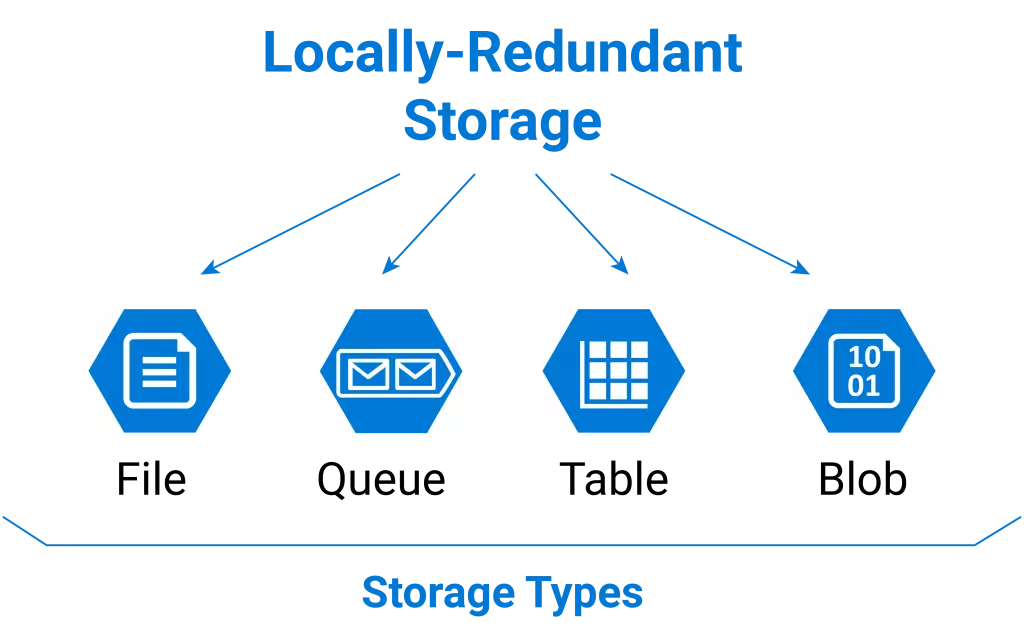
2. Geo-Redundant Storage (GRS)
Geo-Redundant Storage builds upon the redundancy provided by LRS. In addition to replicating data within a single data center, GRS creates another copy of the data in a secondary data center located in a different geographical region. This secondary data center is sufficiently distant to reduce the risk of both centers being affected by the same event.
GRS provides enhanced data durability and availability, protecting against failures at the primary data center and enabling data recovery in the event of a disaster.
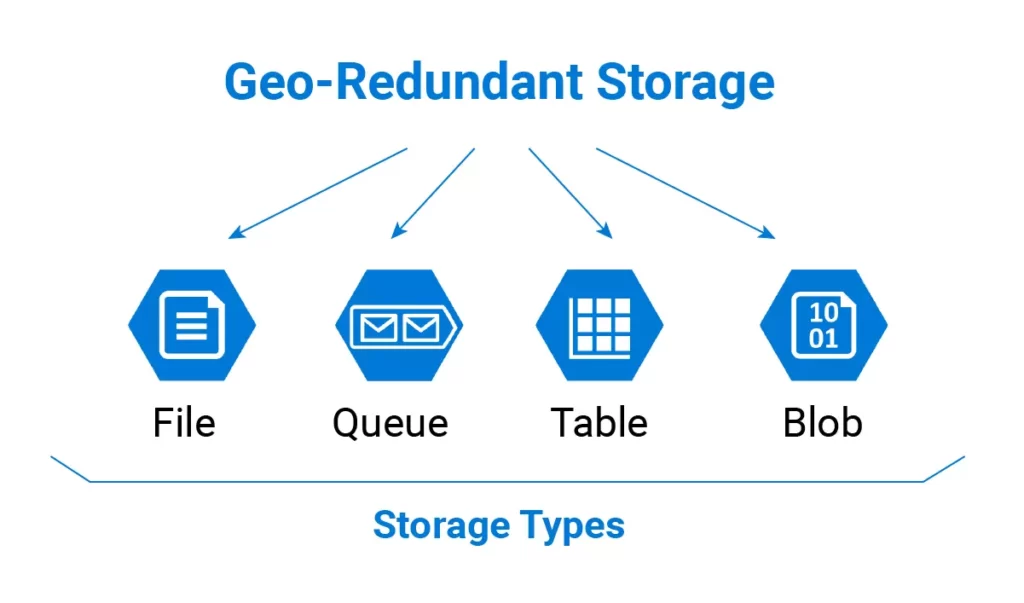
3. Read-Access Geo-Redundant Storage (RA-GRS)
Read-Access Geo-Redundant Storage offers the same redundancy features as GRS but with an additional capability. In addition to replicating data between the primary and secondary data centers, RA-GRS allows read access to the data in the secondary data center. This means that if the primary data center becomes unavailable, applications can still read data from the secondary data center.
RA-GRS provides increased availability and business continuity by enabling read access during primary data center outages.
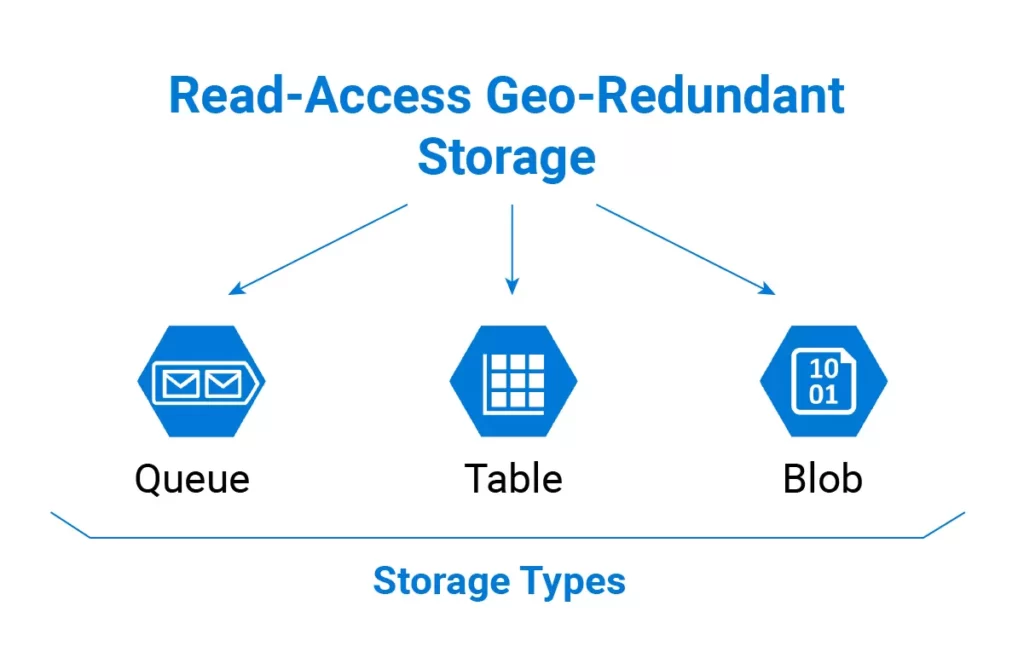
4. Zone Redundant Storage (ZRS)
Zone Redundant Storage is designed for scenarios that require high availability within a single region. It replicates data synchronously across multiple availability zones within the same region. Availability zones are physically separate data centers within a region, providing isolation from failures affecting a single data center.
ZRS offers increased durability and availability compared to LRS by distributing data across multiple zones. This redundancy level is ideal for applications that require low-latency access to data and protection against failures at the data center level.
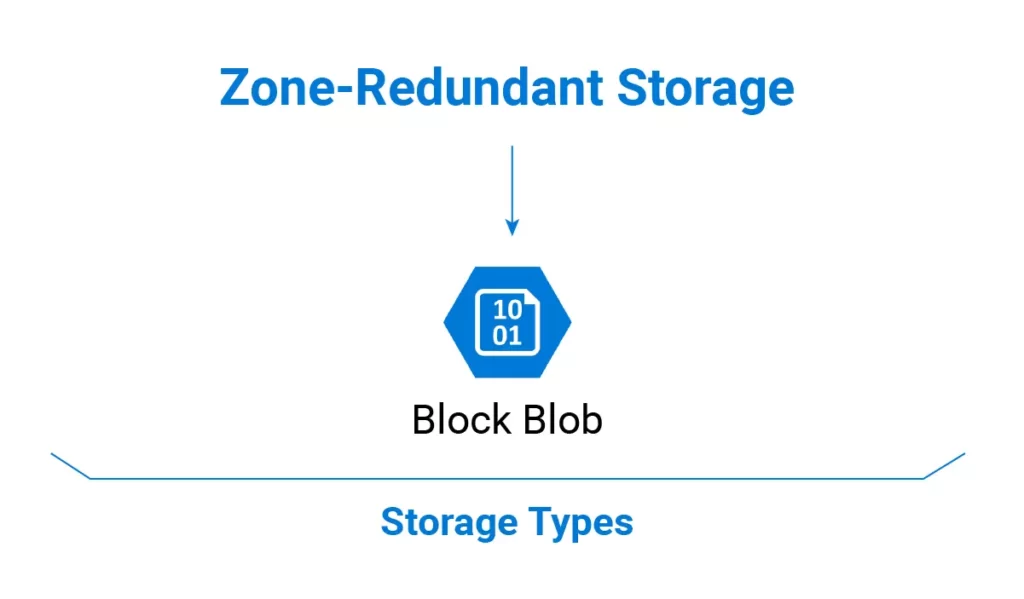
5. Disk Storage Redundancy
Disk Storage Redundancy is specific to Azure Disk Storage, which provides persistent block-level storage for virtual machines. Azure offers two types of redundancy for managed disks: Standard and Premium. Standard storage provides locally-redundant redundancy within a single storage scale unit (SSU).
Premium storage, on the other hand, provides three types of redundancy: Zone Redundant, Zone Redundant with Read Access (ZRS/ZRS-A), and Geo-Redundant (GRS). These redundancy options allow you to choose the appropriate level of durability and availability for your disk storage based on your application requirements.
By offering multiple redundancy options, Azure Storage enables organizations to choose the level of data durability and availability that best suits their needs. Whether it’s protecting against hardware failures, regional disasters, or maintaining high availability within a single region, Azure Storage redundancy options provide the necessary safeguards to ensure the safety and accessibility of your data.
Also Read: AWS vs Azure vs Google Cloud: Choose the Best Cloud Platform
Microsoft Azure Storage Account
A Microsoft Azure Storage Account is a foundational construct in Azure that provides a unique namespace to store and manage data objects in the cloud. It serves as a logical container for organizing and accessing various types of data stored in Azure Storage services, such as blobs, tables, queues, and files.
When you create a storage account, you specify its unique name and choose the desired settings, such as the storage redundancy type, access tiers, and performance characteristics. Once the storage account is created, you can use it to store and retrieve data from Azure Storage services based on your application’s requirements.
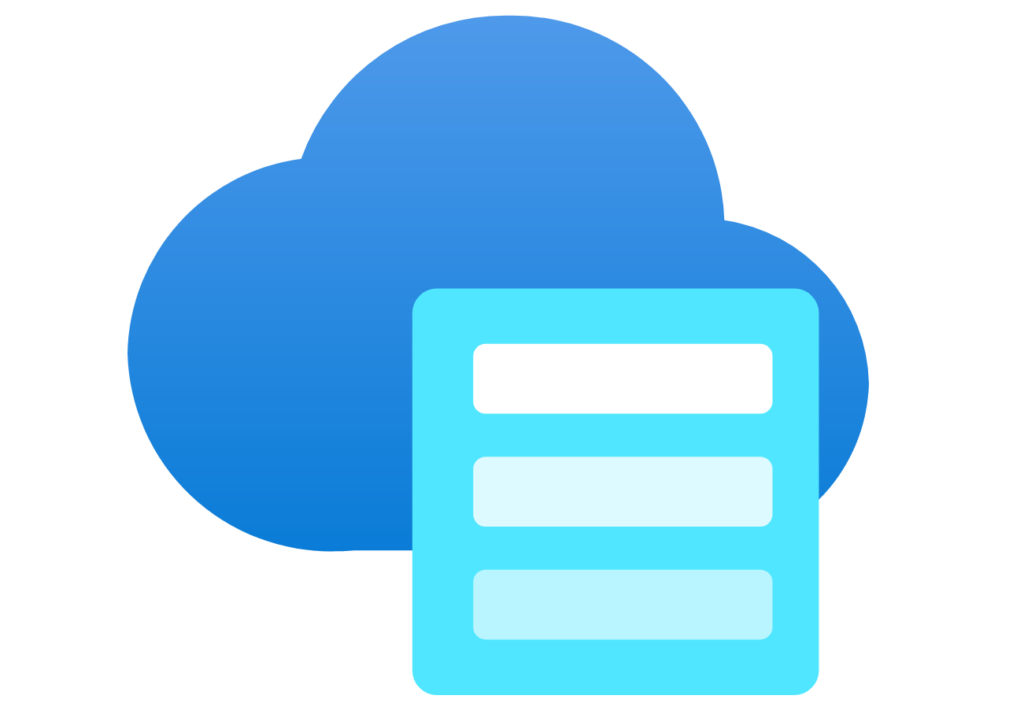
Check Out: Our Detailed blog On Azure Storage Account
Azure Storage Security
Azure Storage provides several security measures to protect data stored within it. Here, we will explore two important aspects of Azure Storage security: encryption at rest and client-side encryption.
1. Encryption at Rest
Encryption at rest is a fundamental security feature in Azure Storage that ensures data is encrypted while it is stored. Azure Storage automatically encrypts data at rest using Azure Storage Service Encryption (SSE). SSE encrypts the data using strong encryption algorithms and manages the encryption keys transparently, relieving you of the burden of key management.
Key points about encryption at rest in Azure Storage:
Transparent Encryption: SSE encrypts data behind the scenes, meaning you don’t need to make any changes to your applications to enable encryption. It is automatically applied to all data stored in Azure Storage.
Strong Encryption: SSE uses industry-standard encryption algorithms like AES-256 to encrypt your data. This ensures that even if unauthorized access occurs, the data remains protected and unreadable.
Key Management: SSE handles the management of encryption keys for you. It automatically manages and rotates the encryption keys, ensuring the security of your data without requiring any additional effort on your part.
Compliance: Encryption at rest with SSE helps you meet compliance requirements for data security, such as GDPR, HIPAA, and ISO 27001. By encrypting data at rest, you can maintain the confidentiality and integrity of sensitive data.
2. Client-Side Encryption
In addition to encryption at rest, Azure Storage also supports client-side encryption. Client-side encryption allows you to encrypt the data before it is sent to Azure Storage. This provides an additional layer of security and gives you more control over the encryption process.
Key points about client-side encryption in Azure Storage:
Enhanced Data Control: With client-side encryption, you have full control over the encryption process. You can encrypt the data on your client machines or servers before sending it to Azure Storage. This means that the data is already encrypted before it leaves your environment, ensuring that only encrypted data is transmitted and stored in Azure.
Encryption Options: Client-side encryption allows you to choose the encryption algorithms and key management processes that best fit your security requirements. You can use your own encryption libraries or tools to encrypt the data using your preferred encryption algorithms and key management practices.
Key Management: With client-side encryption, you are responsible for managing the encryption keys. You have control over key generation, storage, rotation, and access. This provides you with greater flexibility and control over the encryption keys and ensures that only authorized entities can decrypt the data.
Secure Transmission: In client-side encryption, the encrypted data is transmitted to Azure Storage over a secure channel, such as HTTPS. This ensures that the data remains protected during transit and reduces the risk of unauthorized access.
By combining encryption at rest and client-side encryption, Azure Storage offers robust security measures to protect your data. Encryption at rest with SSE provides automatic encryption and key management, while client-side encryption empowers you with additional control over the encryption process.
These security measures help you maintain the confidentiality and integrity of your data stored in Azure Storage, meeting compliance requirements and ensuring the privacy of your sensitive information.
Check Out: Top 10 Microsoft Azure Security Best Practices
Azure Storage Pricing
Azure Storage offers flexible pricing options based on the specific services and features you choose. The pricing structure takes into account factors such as storage capacity, data transfer, redundancy options, and access tiers. Let’s explore the key aspects of Azure Storage pricing:
1. Storage Capacity
Azure Storage pricing is influenced by the amount of storage capacity you consume. The pricing is typically based on the total amount of data stored in your storage account, including blobs, tables, queues, and files. The storage capacity is measured in gigabytes (GB) or terabytes (TB) per month. The more data you store, the higher the storage costs will be.
2. Data Transfer
Data transfer refers to the movement of data in and out of your Azure Storage account. It includes data ingress (incoming data) and egress (outgoing data). Azure offers free inbound data transfer, meaning you don’t incur any charges when data is uploaded to your storage account. However, outbound data transfer is subject to pricing based on the volume of data transferred and the destination region.
3. Redundancy Options
The choice of redundancy options in Azure Storage affects the pricing. Azure provides various redundancy levels, such as Locally-Redundant Storage (LRS), Geo-Redundant Storage (GRS), Read-Access Geo-Redundant Storage (RA-GRS), and Zone Redundant Storage (ZRS). Redundant storage options generally come at a higher cost due to the added data replication and durability guarantees they offer.
4. Access Tiers
Azure Storage offers multiple access tiers for blob storage, including Hot, Cool, and Archive tiers. The access tiers determine the availability and cost of accessing the data stored in blob containers. The Hot tier offers immediate access at a higher storage cost, while the Cool and Archive tiers provide cost-effective storage with delayed retrieval times. The choice of access tier depends on the frequency of data access and the required response times.
5. Transaction Costs
Azure Storage pricing may include transaction costs for specific operations performed on your storage account, such as read and write operations, listing or enumerating objects, and metadata operations. These costs are typically measured in terms of the number of transactions performed and can vary based on the storage service being used.
6. Additional Services
Azure Storage offers integration with several additional services that can enhance its functionality. These services include Azure Data Transfer, Azure CDN (Content Delivery Network), and Azure Import/Export. While these services provide valuable features, it’s important to be aware that they may incur separate charges.
It’s important to note that Azure Storage pricing is influenced by various factors, including the region where your storage account is deployed, the type of storage service utilized (such as Blob storage, File storage, or Queue storage), and any applicable discounts or pricing plans you have.
To obtain accurate pricing estimates for your specific storage requirements, you can use the Azure Pricing Calculator or refer to the Azure Storage pricing documentation. These resources offer detailed information on pricing models, region-specific pricing details, and any available promotions or discounts.
By understanding the pricing factors and making informed choices based on your storage needs, you can optimize costs and effectively manage your budget while benefiting from the powerful storage capabilities provided by Azure Storage.
Conclusion
Microsoft Azure Storage empowers organizations with a reliable, scalable, and secure cloud storage solution. By leveraging the various storage types, redundancy options, security measures, and integration capabilities offered by Azure Storage, businesses can efficiently manage their data and unlock the full potential of their cloud solutions. Explore Azure Storage today and take your storage capabilities to new heights!
FAQs
Q1. What is Azure storage?
Azure Storage is a cloud-based storage solution provided by Microsoft Azure, offering durable and scalable storage for structured, unstructured, and semi-structured data.
Q2. Why do we need Azure storage?
Azure Storage enables organizations to securely store, manage, and access their data in the cloud, providing scalability, durability, and accessibility to support various applications and workloads.
Q3. What are the storage levels in Azure?
Azure Storage offers storage types such as Blob Storage, Table Storage, File Storage, Queue Storage, and Disk Storage, each optimized for specific data storage requirements.
Q4. What is the size of Azure storage?
Azure Storage can scale from gigabytes to petabytes, allowing you to store and manage data of any size based on your requirements.
Q5. Can I access data stored in Azure Storage from anywhere?
Yes, Azure Storage provides global accessibility, allowing you to access your data securely from anywhere using authentication mechanisms.
Q6. How can I secure data stored in Azure Storage?
Azure Storage offers encryption at rest, automatically encrypting your data, and supports client-side encryption, allowing you to encrypt data before storing it. This ensures data security and privacy.
Q7. How is data stored in Azure Storage?
Azure Storage uses a distributed architecture to store data across multiple storage nodes, ensuring redundancy, durability, and high availability.

